Experimenting Landscapes: Testing the Limits of the Garden is the newest book about the International Garden Festival at Métis, Québec. Full of helpful insights from the author Emily Waugh, the book presents photos and essays analyzing some of the Festival’s experimental gardens. Focusing on a selection of gardens from the last ten years, the book suggests five categories or methods of investigation that help readers position the gardens within a larger context.
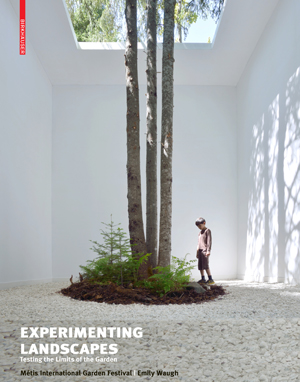
This cover photo shows Courtesy of Nature, by Johan Selbing and Anouk Vogel. It is one of my favourite installations in recent years.
Waugh’s categories ask us to consider how some gardens “Disaggregate and Re-present” or “Focus Within Frames” to help us see things we might otherwise miss; how “Altered Viewpoints” and “Unexpected Materials and Formats” give new perspectives and how “Landscape as a Living Experience” brings richer awareness.
True to its title, the gardens selected stretch the definition of garden and test its limits. And all to the good, in my opinion.
“Disaggregate and Re-Present” examines gardens that help us see the details — the trees within the forest, as it were — by breaking a big picture into its component parts. One of the most successful is Tiny Taxonomies by Rosetta Elkins, where ordinary plants that form the floor of a boreal forest are re-presented in mirrored cylinders of different heights.
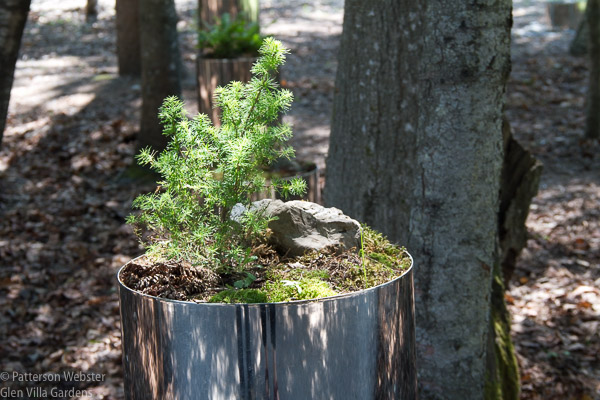
Tiny Taxonomies by Rosetta Elkins. By removing plants from their original context, Elkins helps us see them as something special, non-commercial species with their own beauty.
“Focusing within Frames” is a familiar concept in garden design. Openings in hedges, tall trees at key locations, allées that lead our eyes to a special object or view — these tricks have been used by gardeners for centuries. At the International Garden Festival, though, the idea is expanded beyond the familiar. A variety of types of frames draw our attention to our surroundings, to views or objects that are so familiar we no longer see them. One of the featured installations is the forest scene presented on the book’s cover, a project by Johan Selbing and Anouk Vogel with the beautifully appropriate name, Courtesy of Nature. Ordinary trees and ferns become almost sacred by virtue of the building that surrounds them, and inside the pristine enclosure we engage with these familiar landscape elements in new ways.
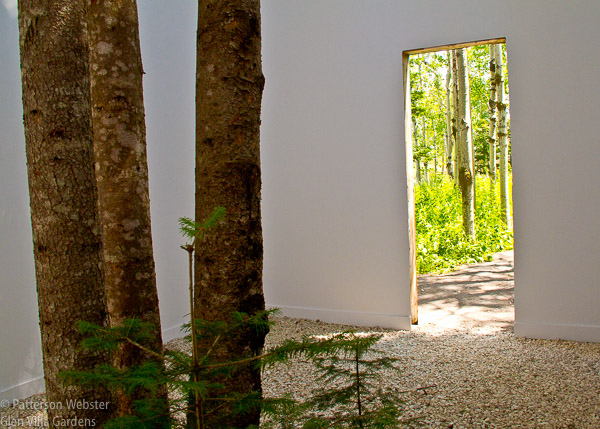
This view of Courtesy of Nature shows the doorway to the gallery-like box that encloses a section of the existing forest. Setting the trees apart from the forest emphasizes the significance and beauty of the familiar.
Two other gardens that I find particularly successful are included in this category. One is the now permanent Réflexions colorées by Hal Ingberg, an installation that plays with perceptions in a way that engages everyone who sees it.
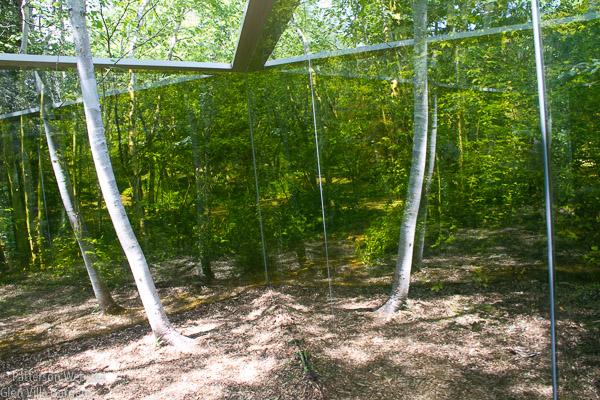
Semi-reflective glass mirrors the surrounding forest and allows us to see ourselves reflected, separate from yet also a part of the forest. I have many, many photos of this installation. Each time I see it, I have to take more because it looks different in every season and at every time of day. One of my favourite photos shows a tiny grandchild with her nose pressed against the glass, trying to figure out what is inside and what is outside the frame.
Diane Balmori’s Making Circles in the Water focuses our attention on the St. Lawrence River, a key feature of the landscape that had become almost hidden behind a curtain of trees and plants. Small circular cones we can peer through and a series of frames we can walk through limit our sight to a section of the larger scene. These two types of frames, combined with the title that recalls how throwing a rock into water makes rippling circles, connect us physically and emotionally to the surroundings and remind us of how we can affect it.
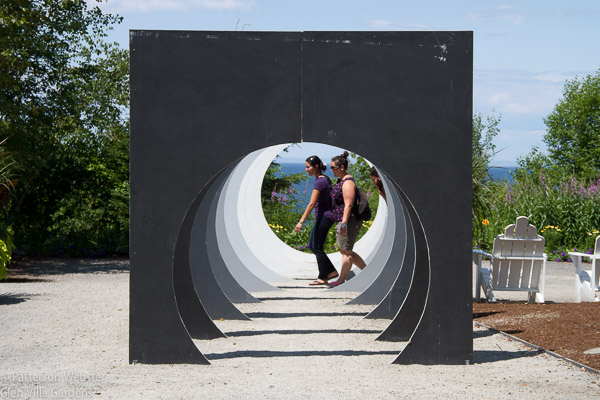
Making Circles in the Water, by Balmori Associates, engages visitors in multiple ways. I have seen children running through the frames, adults standing amid them and staring in both directions, people posing inside the frames to have their photos taken. The subtle colour gradations draw the eye through the frames to the water beyond.
What I particularly appreciate about the experimental landscapes at the International Garden Festival is how they alter my views, both visually and mentally, of even the most familiar things. Tree Stands by relais Landschaftsarchitekten placed ladders in a grove of trees; anyone brave enough to climb a ladder would see the forest from a new vantage point. Camouflage View by Arenda/Lasch used angled mirrors to simultaneously hide and reveal the surroundings. While my photo may show the view onto the St Lawrence River quite clearly, walking through the space was a different experience. With each step, the angled view changed, confusing and distorting background and foreground in a way that made the surroundings impossible to ignore.
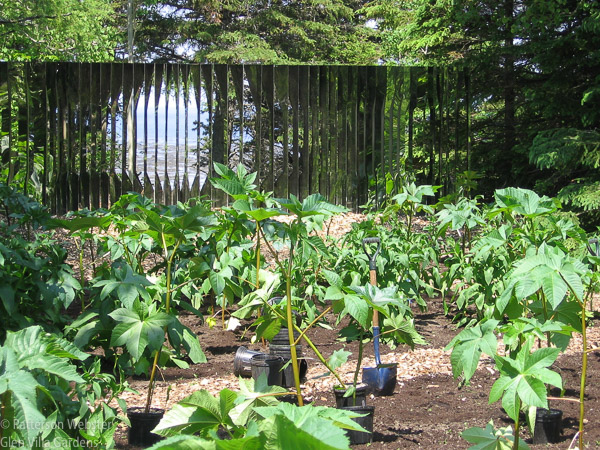
Camouflage View by Aranda/Lasch. I saw this installation early in June, 2006, while plants were still in their pots.
Ordinary materials used in unexpected ways can challenge our expectations. Round Up by Legge Lewis Legge shifted a grass lawn from horizontal to vertical, by way of turf hills covered with sod held in place with packing straps.
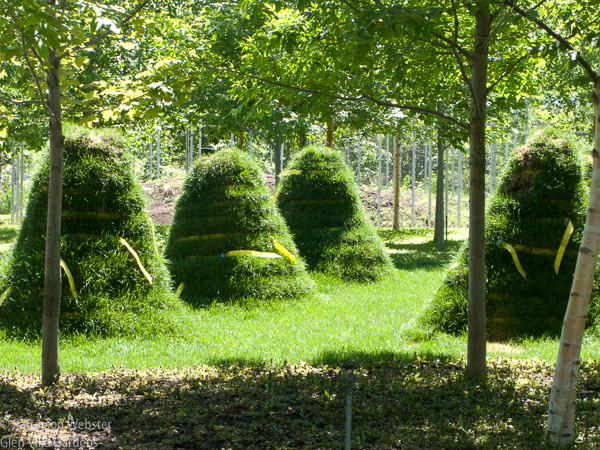
Round Up by Legge Lewis Legge. When I saw them, the hills were fairly uniform but as the season progressed, they changed shape, slumping and shifting as the grass grew longer.
The last of Waugh’s five categories presents the landscape as a living experience. Two of the most powerful installations she covers in this section are Afterburn by Civilian Projects, and This Rocks! Get Lost! by Michael Van Valkenburgh Associates.
Afterburn shows the destructive and regenerative power of fire. Charred posts suggest a landscape destroyed by fire which, although initially barren, will become alive again as pioneer species take root and grow.
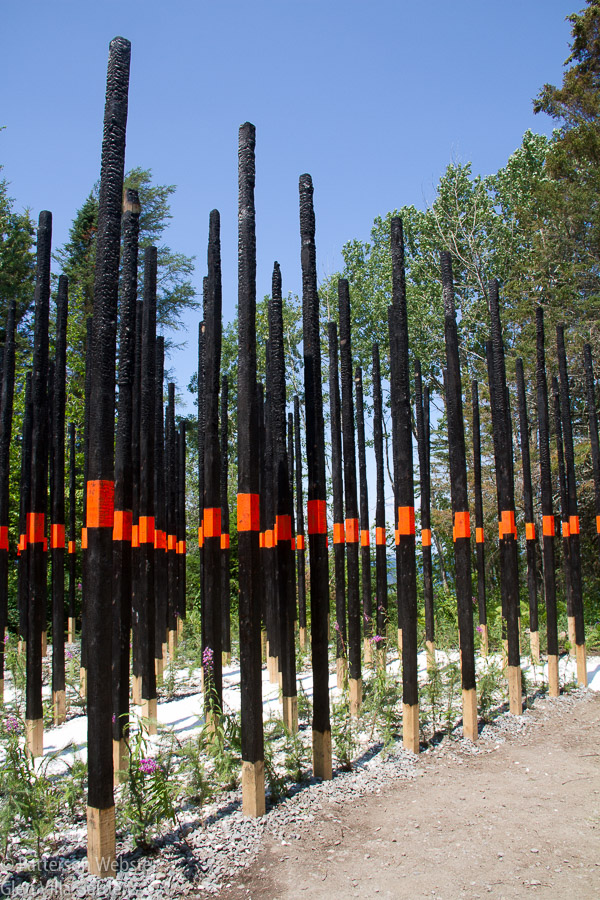
The smell of charred wood was strong on the day I visited. I loved the aesthetics of this installations, in particular the contrast of colours — the orange surveyor’s paint and the silvery shimmer of the scorched wood set off against the bright blue sky above.
Each entry that Waugh presents includes quotes from the garden designer that speak to intent. Michael Van Valkenburgh wanted to do a project “where the power of landscape material was the whole idea.” This Rocks! Get Lost! positions five enormous chunks of Vermont marble in a woodland site. The raw power of the stone drew me and every other visitor I saw into close contact with the stones.
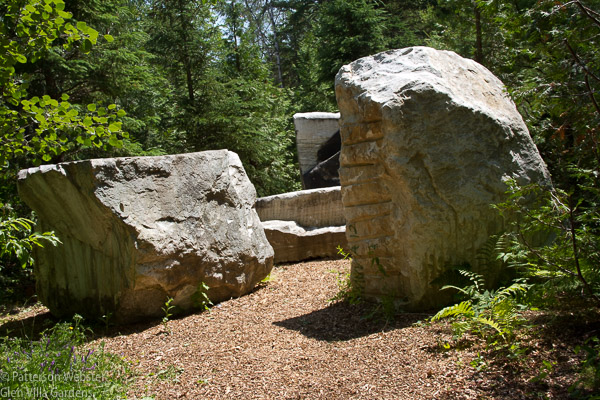
When I saw This Rocks! Get Lost! by Michael Van Valkenburgh Associates, I had to rub my hand against each piece, to sit and be quiet, to give myself time to feel the weight of the marble, a material more often seen in small polished pieces.
Essays by international garden writers and designers add heft to Experimenting Landscapes, making it much more than a picture book reviewing festival gardens from previous years. Both the author Emily Waugh and the Garden and Festival Director Alexander Reford connect the festival to the garden’s beginnings, when Elsie Reford began what she called ‘adventuring’ with soils, planters and hybrid species. She tested the limits of her garden in a climate where she was on her own. As her great-grandson writes, “with nobody to compare herself to, she could only be constrained by her own lack of imagination.”
For me, that encapsulates the value of seeing and engaging with experimental gardens. They help me ‘adventure.’ They push me to fight against the limits of my imagination, to look, to see,, to comprehend. Even to imitate.
Several years before I saw Round Up, I used grass vertically to create the Grass Snake at Glen Villa. The idea didn’t come all at once, it developed in a back and forth dialogue with my friend, the landscape architect Myke Hodgins. The initial impulse, though, came from an experimental garden I saw pictured in a book.
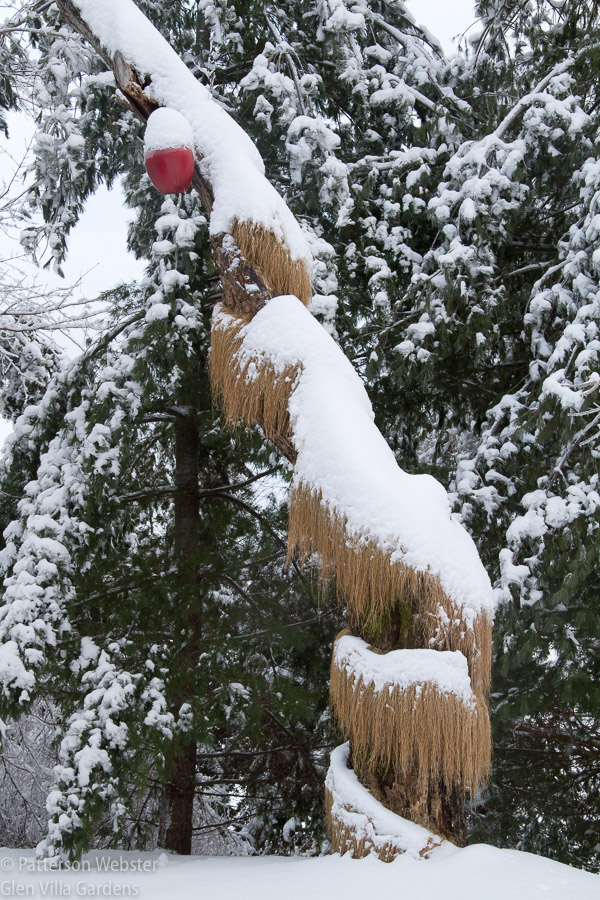
Snow hides the head of the grass snake but emphasizes the curves of its shaggy grass ‘skin.’ The apple remains out of reach, regardless of season.
Currently I am working on two projects that fall within Emily Waugh’s categories. In one I’m using unexpected materials and formats in a new way; in another I’m altering the viewpoint. Both, I hope, will not be constrained by a lack of imagination. Rather, in the process of creating them I hope they will open my eyes to new possibilities and new ways of seeing and understanding the environment I am a part of.
What will my experiments do for others? Will they open eyes or close them? I know that many people find experimental gardens off-putting. They are Irritated by what they see, or dismissive. Or worst of all, they are left indifferent. While I regret these reactions, I understand them. Like many pieces of contemporary art, experimental and conceptual gardens aren’t always easy to get your head around. They run counter to everyday ideas about what gardens are. But I hope that instead of shutting their minds to these gardens, people will give them a second look. Perhaps even a third. Waugh’s excellent book is a good place to begin.





